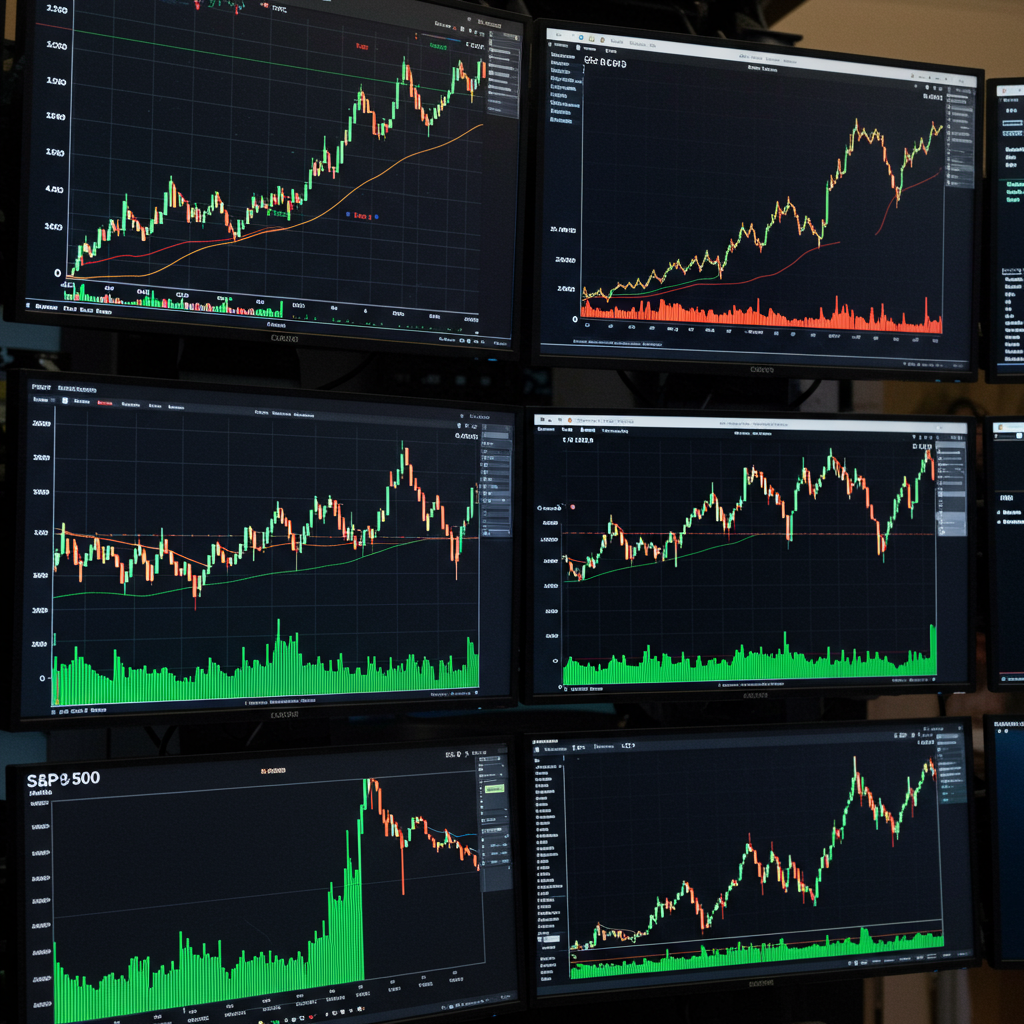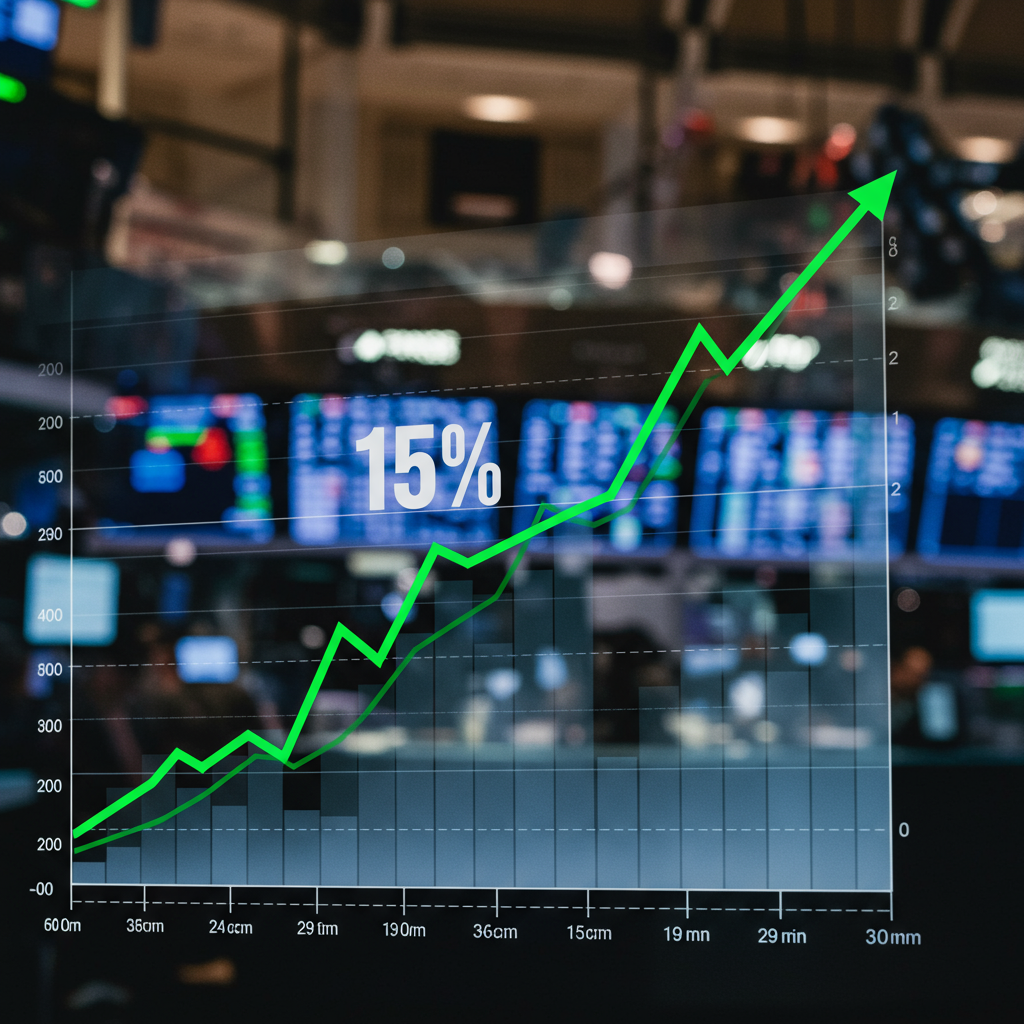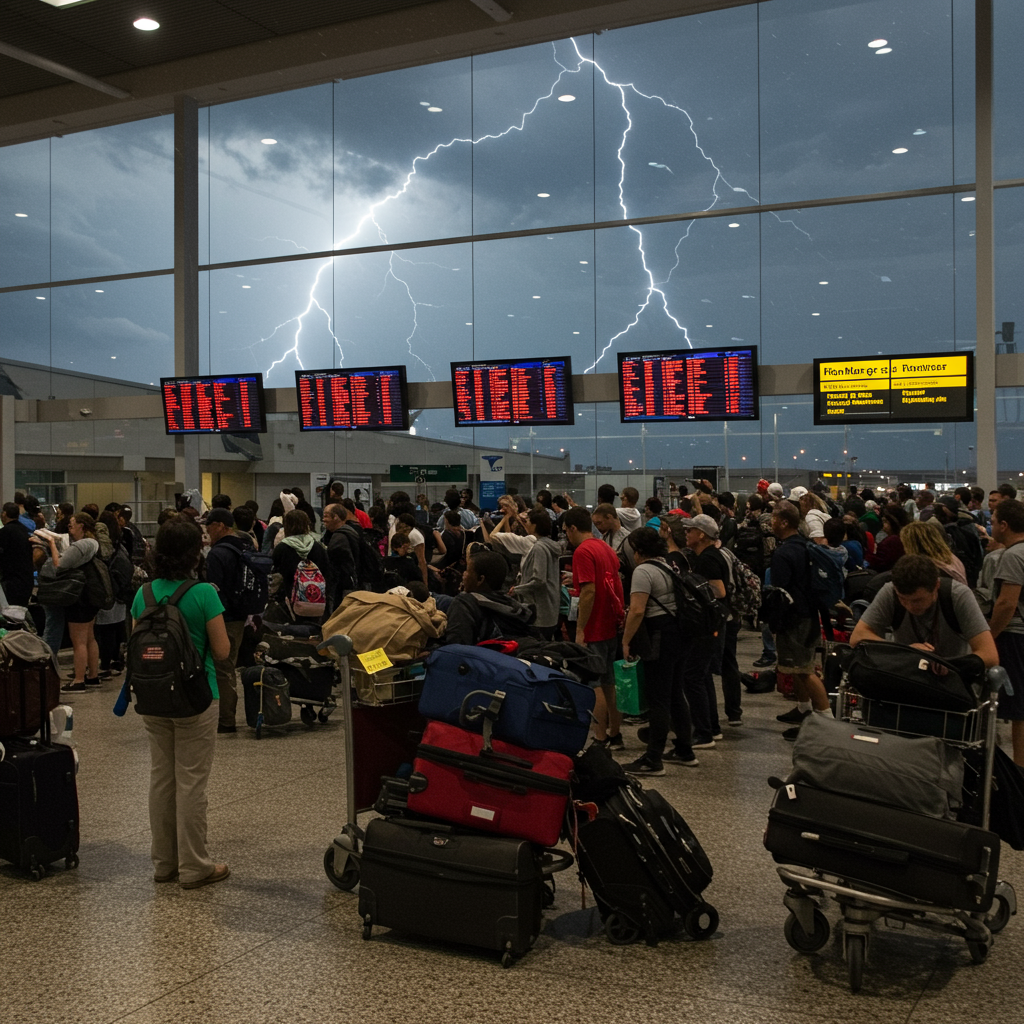US stock futures showed early gains Sunday evening, signaling continued optimism for the trading week ahead. This follows a remarkable stretch for equity markets, culminating in major benchmarks like the S&P 500 and Nasdaq Composite reaching fresh record highs on Friday. Investors are navigating a complex landscape, balancing positive momentum driven by cooling geopolitical tensions and trade developments against potential headwinds from political uncertainty and shifts in economic data.
US Equities Ascend: S&P 500 and Nasdaq Hit Peak Performance
Friday, June 27, 2025, marked a significant session for US stocks. The S&P 500 index closed at a new all-time high, finishing the day up approximately 0.5% at 6,173.07. This surpassed its previous record of 6,147.43 and represented its first record close in over four months. The tech-heavy Nasdaq Composite also achieved an all-time high, climbing about 0.5% and securing its first record close since December. Meanwhile, the Dow Jones Industrial Average added nearly 1% on Friday, contributing to a strong close for the week across the board.
These gains capped off an impressive month for stocks. In June, the S&P 500 surged by 4.4%, while the Nasdaq, fueled by technology sector strength, jumped by nearly 6.1%. The Dow recorded a solid 3.7% gain month-to-date. This broad market recovery is a stark contrast to earlier in the year. At its low point in April, the S&P 500 had declined by nearly 18% year-to-date, primarily due to escalating global trade and tariff tensions that previously rattled market sentiment.
Unpacking the Rally: Geopolitics, Trade, and Earnings Confidence
The recent surge in stock values can be attributed to a confluence of factors that shifted investor sentiment towards a more “risk-on” stance. A significant catalyst in the days leading up to Friday’s records was the perceived de-escalation of geopolitical tensions, particularly the fragile ceasefire between Israel and Iran. While reports suggested violations from both sides, President Trump’s public efforts to uphold the agreement and signals of easing “maximum pressure” on Iran (like allowing China oil purchases) significantly reduced fears of a wider conflict. This helped lift a cloud that had previously unsettled financial markets and contributed to declines in safe-haven assets like gold and defense stocks, while boosting sectors sensitive to lower oil prices, such as airlines.
Optimism surrounding trade negotiations also played a crucial role. Early on Friday, markets reacted positively to Commerce Secretary Howard Lutnick’s announcement late Thursday that a framework for trade relations had been finalized between China and the United States. He also indicated that the Trump administration anticipated reaching deals with 10 other major trading partners soon. This positive news on trade provided a strong tailwind for equities.
Furthermore, investors found reassurance in corporate performance metrics. According to data from FactSet, a higher-than-average number of S&P 500 companies were issuing positive earnings guidance for the second quarter. Out of over 110 companies providing guidance, 51 issued positive forecasts, exceeding both the 5-year average of 42 and the 10-year average of 39. While 59 companies issued negative guidance and overall estimated year-over-year earnings growth for the S&P 500 in Q2 was forecast at a potentially slower 5% (the lowest since Q4 2023), the inclination of more companies to signal positive outcomes provided a layer of fundamental support for the market rally.
Navigating the “Wall of Worry”: Headwinds and Analyst Views
Despite the prevailing bullish sentiment, the market faces potential headwinds that could inject volatility. Global trade remains a sensitive area. Late on Friday, market momentum briefly pulled back after President Trump announced on Truth Social the immediate “terminating ALL discussions on Trade with Canada.” This response to Canada’s proposed digital services tax on American tech firms highlights how quickly trade disputes can resurface and impact sentiment, threatening new tariffs within a week according to external reports.
Political developments in Washington are also on investors’ radar. The fate of President Trump’s significant legislative package, described as “one, big, beautiful,” is being closely watched. While it narrowly passed a key procedural vote in the Senate, its path through the House remains uncertain due to some GOP lawmakers expressing reservations about revisions. The potential passage or failure of this bill could have economic implications that influence market direction.
Comments from Federal Reserve officials regarding interest rates continue to be digested. Fed Chair Jerome Powell recently indicated the central bank is in no rush to cut rates. He stated the Fed is “well-positioned to wait” to assess the full impact of President Trump’s tariffs on inflation before adjusting monetary policy. This patient stance, supported by other Fed officials like New York Fed President John Williams, contrasts with President Trump’s public criticism advocating for immediate, aggressive rate cuts. The uncertainty surrounding the tariff pass-through to consumer prices and the Fed’s reaction function remains a factor for investors.
Analysts acknowledge the market’s current resilience. Ken Mahoney, CEO of Mahoney Asset Management, noted that bearish narratives like Middle East conflict, tariffs, and soft economic data have been invalidated by price action. He remarked, “Every chance the market has had to break down has failed. Instead, it continues to do what bull markets do best: climb the wall of worry.” While expecting the run to continue, he cautioned that volatility, including potential downside swings, is still likely. Some analysts, like those at Barclays, also warn that despite the ceasefire, markets remain vulnerable to renewed escalation between Israel and Iran, which could prompt funds to reduce equity exposure.
Futures Hint at Momentum: What Sunday’s Rise Signals
The movement in stock futures Sunday evening underscores the prevailing positive mood as investors prepared for the new trading week. Shortly after 6 p.m. ET, S&P 500 futures and Nasdaq 100 futures were each trending slightly higher, adding around 0.1%. Futures tied to the Dow Jones Industrial Average showed a more notable gain, climbing 163 points, or 0.4%.
This early uptick in futures suggests that the optimism from Friday’s record highs and the factors driving the June rally carried over into the start of the week. While futures movements can be tentative and don’t guarantee the day’s market open, they often provide an initial indication of investor sentiment and potential direction following a strong period. For investors, the rise in futures indicates a likely continuation of the positive momentum, potentially presenting opportunities to “buy the dip” on any intraday pullbacks, as mentioned by some market participants.
Notable Stock Movements Reflect Shifting Dynamics
Recent market activity saw significant price swings in individual stocks, often tied to the broader themes influencing the indices:
Technology and AI Leaders: Stocks positioned in the Artificial Intelligence space continued their strong performance. Nvidia and Microsoft both hit new record highs, with analysts highlighting Nvidia’s dominance in AI chips and Microsoft’s leverage through Copilot and Azure monetization. Broadcom also reached a new all-time high, bolstered by upgrades based on its ASIC business confidence. The outperformance of semiconductor ETFs underscored the market’s enthusiastic focus on the AI growth opportunity.
Earnings-Driven Movers: Nike shares soared after beating earnings expectations and outlining strategies to mitigate tariff impacts, including shifting production and planned price increases. Paychex, conversely, saw its stock drop after missing sales estimates and issuing weak guidance, with growth largely attributed to acquisitions rather than core business strength. BlackBerry jumped after beating results and raising guidance based on demand for its automotive software.
Geopolitical and Trade Sensitivity: Defense stocks like Palantir Technologies, Northrop Grumman, and Lockheed Martin declined as Middle East tensions eased, potentially impacting demand for military contracts and aligning with a proposed lower defense budget. Energy stocks also fell sharply with oil prices, which retreated from earlier highs as supply disruption fears faded. Conversely, shares of domestic rare earth producers like MP Materials slumped after a US-China trade framework included China’s pledge to export rare earths to the US, easing supply concerns. FedEx shares slid after the company suspended its full-year forecast, citing uncertainty related to US trade policies and their impact on air freight demand.
Sector-Specific Catalysts: Airline stocks gained from lower oil prices. Cruise lines like Carnival saw surges after strong earnings and optimistic outlooks, indicating robust consumer demand despite recent geopolitical events. Enphase Energy saw a boost on hopes that Senate action might preserve federal tax credits for residential solar installations. Core Scientific jumped on reports of acquisition talks with Nvidia-backed CoreWeave, signaling a strategic pivot towards AI infrastructure.
Looking Ahead: What Investors Will Watch
As the week unfolds, investors will be keenly focused on several key areas. The progress, or lack thereof, on President Trump’s legislative bill in Congress will remain a point of interest. Further developments in global trade negotiations, particularly regarding Canada and the execution of the US-China framework, could quickly sway sentiment.
Upcoming economic data releases will provide more insights into the health of the US economy, influencing expectations for future Fed actions. While recent consumer confidence data was weaker than expected, the market remains fixated on inflation trends and labor market strength. Finally, the continuation of the earnings season will offer company-specific details that can validate or challenge the broader market’s upward trajectory. The ability of companies to meet or exceed expectations and provide optimistic forward guidance will be crucial in sustaining the rally.
Frequently Asked Questions
Why are stock futures rising after the S&P 500 hit a record?
Stock futures are rising because investors are reacting positively to factors that drove US stocks to record highs on Friday, June 27, 2025, and throughout June. Key drivers include a reduction in geopolitical tensions (like the Israel-Iran ceasefire), optimism around progress in US-China trade talks, relief that major tariff threats haven’t materialized, and signs of continued fundamental strength like positive corporate earnings guidance. The futures rise signals that this bullish sentiment is carrying forward into the new trading week.
What significant records did the US stock market achieve recently?
On Friday, June 27, 2025, the S&P 500 index closed at an all-time high of 6,173.07, surpassing its previous record set over four months prior. The Nasdaq Composite also hit a new all-time high, achieving its first record close since December. These milestones followed a strong June performance where the S&P 500 gained 4.4% and the Nasdaq jumped 6.1% month-to-date, reflecting a strong market recovery from earlier declines in the year.
What factors could potentially impact the stock market’s current rally?
Despite the positive momentum, several factors could introduce volatility or challenge the rally. Renewed global trade friction, such as the recent dispute with Canada over digital services taxes, could negatively impact sentiment. Political uncertainty surrounding the passage of key legislation in the US Congress is also a potential headwind. Investors are also watching the Federal Reserve’s stance on interest rates, as Chair Powell has indicated patience while assessing the impact of tariffs on inflation, which could influence future monetary policy decisions and market reactions.
The current market environment is marked by robust gains, fueled by easing global concerns and trade optimism, even as investors remain vigilant about political developments and the Federal Reserve’s path forward. The early rise in futures suggests the “climb the wall of worry” narrative, where the market advances despite potential risks, remains firmly in play as the new trading week begins.
References
- www.investopedia.com
- www.nbcmiami.com
- <a href="https://www.nbcnewyork.com/news/business/money-report/stock-futures-are-little-changed-after-market-shakes-off-irans-retaliation-to-u-s-attacks-live-updates/6312910/?os=dioref253dapp&ref=app”>www.nbcnewyork.com




